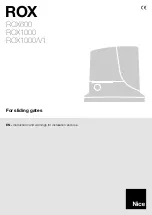
English –
9
4
ELECTRICAL CONNECTIONS
CAUTION! - All electrical connections must be made with the system powered off Incorrect connections can result in damage
and injury.
Fig. 2 shows the hookup of a typical installation; fig. 7 shows the connections to be made on the control unit.
4.1 - Types of electrical cables
Table 3 - Types of electrical cable (see fig. 2)
Connection
Type of cable
Maximum length
A
POWER
3 x 1,5 mm
2
30 m
*
B
C
FLASHER WITH AERIAL
1 cable: 2 x 1,5 mm
2
1 shielded RG58 cable
10 m
10 m (< 5 m recommended)
D
PHOTOCELLS
1 cable: 2 x 0,25 mm
2
(TX)
1 cable: 4 x 0,25 mm
2
(RX)
30 m
30 m
E - F
KEY SWITCH
1 cable: 2 x 0,5 mm
2
**
20 m
*
A power supply cable longer than 30 m may be used provided it has a larger gauge, e.g. 3x2.5mm
2
, and that a safety grounding system is
provided near the automation unit.
**
The two 2 x 0.5 mm
2
cables can be replaced by a single 4 x 0.5 mm
2
cable.
4.2 - Electrical cable connections: fig. 7
Table 4 - Description of electrical connections
Terminals Function
Description
1 - 2
Aerial
- radio receiver aerial input
- aerial integrated into flasher; an external aerial can be used if desired
9 - 12
Step-by-step
input for devices which control movement. NO (Normally Open) contacts can be connected
9 - 10
Stop
- input for devices which lock or stop a movement: NC (Normally Closed) contacts may be connected
- for further details, refer to par. 8.1
9 - 11
Photo
- input for safety devices which when tripped reverse the gate's direction of movement: NC (Normally Closed)
contacts may be used
- for further details, refer to par. 8.1.
5 - 4
Flashing light
- flasher output (230 V auto-intermittent)
- flashes at regular intervals while the gate is moving: 0.5s on, 0.5s off
Warnings
• NC (Normally Closed) input: these must be shorted if not used; if more than one contact is to be connected to the stop input, they must be
connected IN SERIES;
• NO (Normally Open) input: these must be left unconnected if not used; if more than one contact is to be connected to the input, they must
be connected IN PARALLEL.
• Contacts must be mechanical and disconnected from any voltage.
Sensitive
edges
No specific input; use Nice equipment:
- fixed sensitive edges: use the TCE interface
- mobile sensitive edges: use the FT210 unit or IRW interface
Refer to the product’s instruction manual for details
To make the electrical hookup, proceed as described below with reference to fig. 7:
01.
Open the cover: undo the screw and raise the cover
02.
Run the power cable through the hole (leave 20/30 cm of free cable) and connect it to its terminal clamp
03.
Run the cables of the equipment to be installed or already present through the provided hole (leave 20/30 cm of free cable) and connect
them to their terminal clamps (see fig. 14)
04.
Before closing the cover, program the system: chapter 7
05.
Close the cover and tighten down its bolt










































